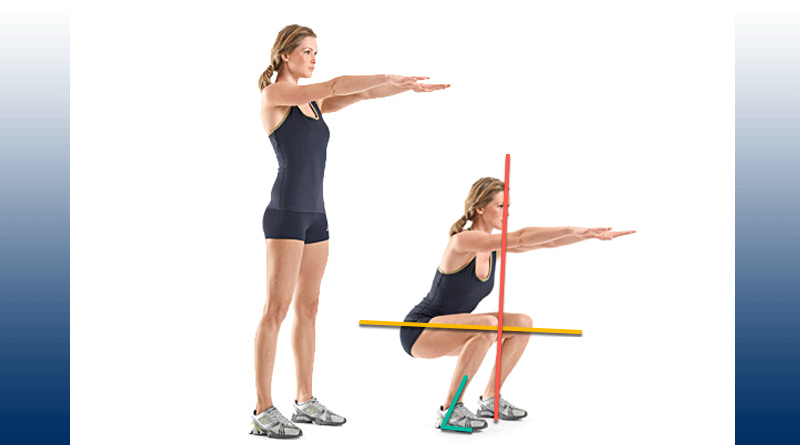The squat position is a foundation of athletic movement. Understanding the mechanics of the squat position is an important component of long-term athletic development.
This diagram is an example of a bodyweight squat (“air squat”).

Although the athlete is at angle relative the camera position, we can look at how her joints and body parts line up to each other and the ground.
The yellow line represents the line of her femur (thigh bone). In this position, her femur is parallel to the ground surface. When we talk about getting “parallel”, it is in this position.
The red line starts at the ground from a position approximately between the end of her foot and running straight up (perpendicular to the ground). Although it is difficult to see clearly from this angle, both her knees and her head are either at or behind this line. In other words, her knees and head are not beyond the end of her feet.
The green line represents the angle between the ground and her tibias (shins). We note that there is a slight angle, which supports the position of her upper body. In order for her to achieve this angle, she has sufficient mobility (flexibility).
Her arm position provides a counterbalance to her center of gravity. This arm position is one of several possible positions. In this example, her arms are parallel to both the ground and her thighs.
It is difficult to tell from this angle, but we can observe that the position of both her knees and feet are slightly turned out – her knees are at about the same angle as her feet. In this position, the ligaments of her knee are supported by the surrounding muscles and tissues.
Compare these two face-on views of an athlete in a squat position after landing from a jump (Lloyd, Meyers, & Oliver, 2011):

In the left picture (A), the athlete’s knees and feet are pointing at the approximately the same angle. In the right picture (B), the athlete’s knees are facing inward relative to the feet (“valgus”). The problem with picture B is that the knee ligaments are under a greater amount of pressure. Rotation and buckling of the knee is a common scenario for ACL tears.
Each athlete has a range of motion based on the angles formed by the hip, knee, and ankle joints in combination with the length and flexibility of the surrounding soft tissue (muscles, tendons, and ligaments). When determining the position (narrow, wide) and angles of the feet (toe out, toe in), it’s important to take into account the range of motion. The ability of the ankle to flex forward (“dorsiflexion”) is a key barrier for many athletes who are unable to achieve a deep squat position.
Here is an example of the positions and angles of the feet (Rusin & Debell, 2018):

Note how based on the positions and angles of the feet, the athlete’s squat position is adjusted (deeper or more shallow squat). In each position, the athlete’s knees are in a proper position. The use of the kettlebell provides a counterbalance (Rusin & Debell, 2018):

The ability to perform an unweighted squat, and to recognize proper positions, is necessary before an athlete can safely perform resistance squat activities such as back squats, front squats, and goblet (kettlebell) squats.
Front squat with spotter (Rusin & Debell, 2018):

The overhead squat is advanced exercise that requires core stability and range of motion through several joints (Welsh Athletics, 2017):

References
Lloyd, R. S., Meyers, R. W., & Oliver, J. L. (2011). The natural development and trainability of plyometric ability during childhood. Strength & Conditioning Journal, 33(2), 23-32.
Rusin, J. & Debell, R. (2018). Anthropometrical considerations for customizing the squat pattern. Personal Trainer Quarterly 5.4.
Welsh Athletics. (2017). Physical preparation. Welsh Athletics Coaching Resource.